instrument panel JEEP WRANGLER 2016 JK / 3.G Owners Manual
[x] Cancel search | Manufacturer: JEEP, Model Year: 2016, Model line: WRANGLER, Model: JEEP WRANGLER 2016 JK / 3.GPages: 705, PDF Size: 5.5 MB
Page 3 of 705

TABLE OF CONTENTSSECTIONPAGE
1INTRODUCTION .
..............................................................3
2THINGS TO KNOW BEFORE STARTING YOUR VEHICLE
.................................11
3UNDERSTANDING THE FEATURES OF YOUR VEHICLE
.................................105
4UNDERSTANDING YOUR INSTRUMENT PANEL
......................................305
5STARTINGANDOPERATING ....................................................429
6WHATTODOINEMERGENCIES..................................................569
7MAINTAININGYOURVEHICLE...................................................593
8MAINTENANCE SCHEDULES
....................................................663
9IF YOU NEED CONSUMER ASSISTANCE
............................................671
10INDEX .....................................................................681
1
2
3
4
5
6
7
8
9
10
Page 10 of 705

WARNINGS AND CAUTIONS
This Owner ’s Manual containsWARNINGSagainst
operating procedures that could result in a collision,
bodily injury and/or death. It also contains CAUTIONS
against procedures that could result in damage to your
vehicle. If you do not read this entire Owner ’s Manual,
you may miss important information. Observe all Warn-
ings and Cautions.
VEHICLE IDENTIFICATION NUMBER
The Vehicle Identification Number (VIN) is found on the
left front corner of the instrument panel pad, visible from
outside of the vehicle through the windshield. This
number also appears underbody, on the right side of the
frame rail near the center of the vehicle, as well as on the
Automobile Information Disclosure Label affixed to a
window on your vehicle. Save this label for a convenient
record of your vehicle identification number and optional
equipment. The VIN is also stamped on either right or left hand side
of the engine block.
NOTE:
It is illegal to remove or alter the VIN plate.
Vehicle Identification Number
8 INTRODUCTION
Page 25 of 705
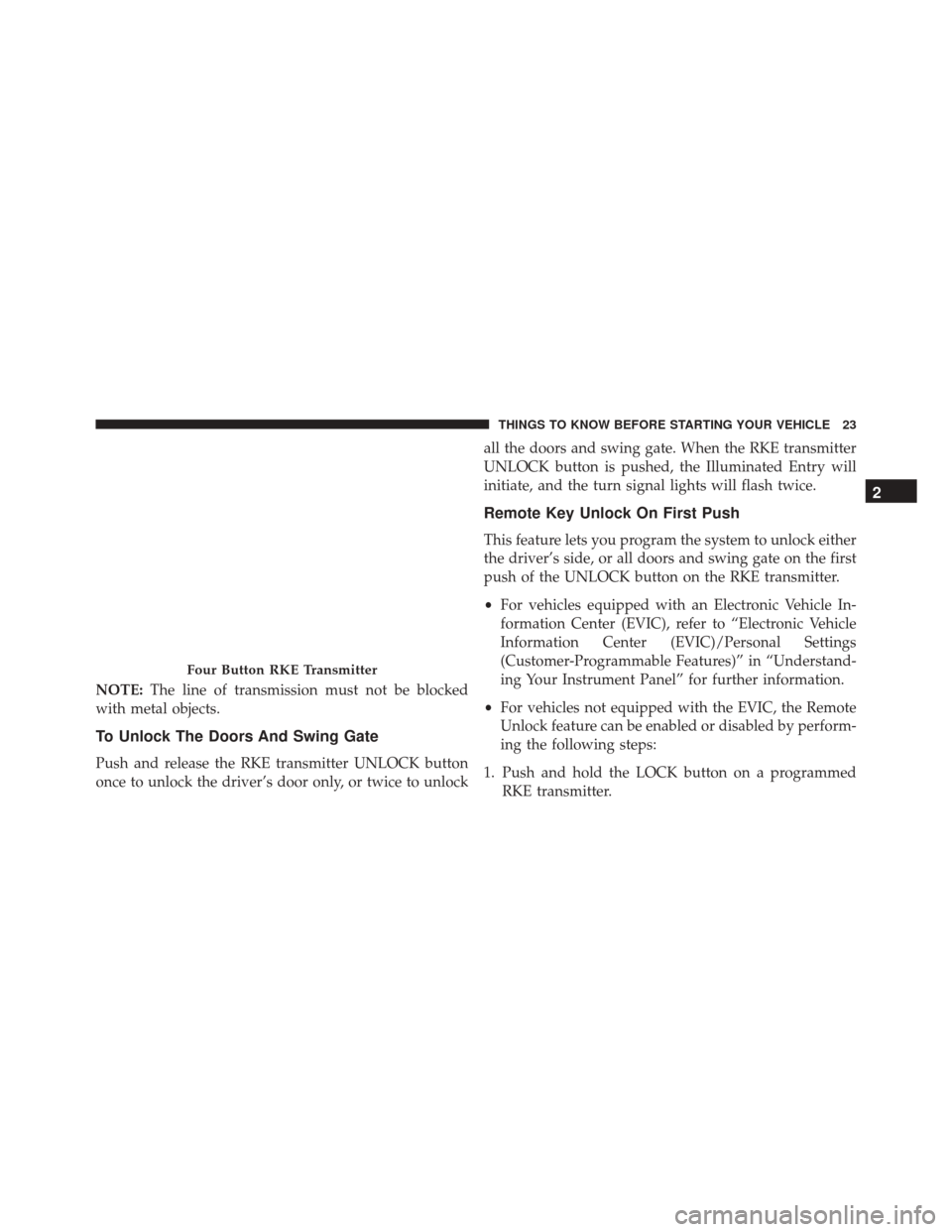
NOTE:The line of transmission must not be blocked
with metal objects.
To Unlock The Doors And Swing Gate
Push and release the RKE transmitter UNLOCK button
once to unlock the driver’s door only, or twice to unlock all the doors and swing gate. When the RKE transmitter
UNLOCK button is pushed, the Illuminated Entry will
initiate, and the turn signal lights will flash twice.
Remote Key Unlock On First Push
This feature lets you program the system to unlock either
the driver’s side, or all doors and swing gate on the first
push of the UNLOCK button on the RKE transmitter.
•
For vehicles equipped with an Electronic Vehicle In-
formation Center (EVIC), refer to “Electronic Vehicle
Information Center (EVIC)/Personal Settings
(Customer-Programmable Features)” in “Understand-
ing Your Instrument Panel” for further information.
• For vehicles not equipped with the EVIC, the Remote
Unlock feature can be enabled or disabled by perform-
ing the following steps:
1. Push and hold the LOCK button on a programmed RKE transmitter.
Four Button RKE Transmitter
2
THINGS TO KNOW BEFORE STARTING YOUR VEHICLE 23
Page 27 of 705
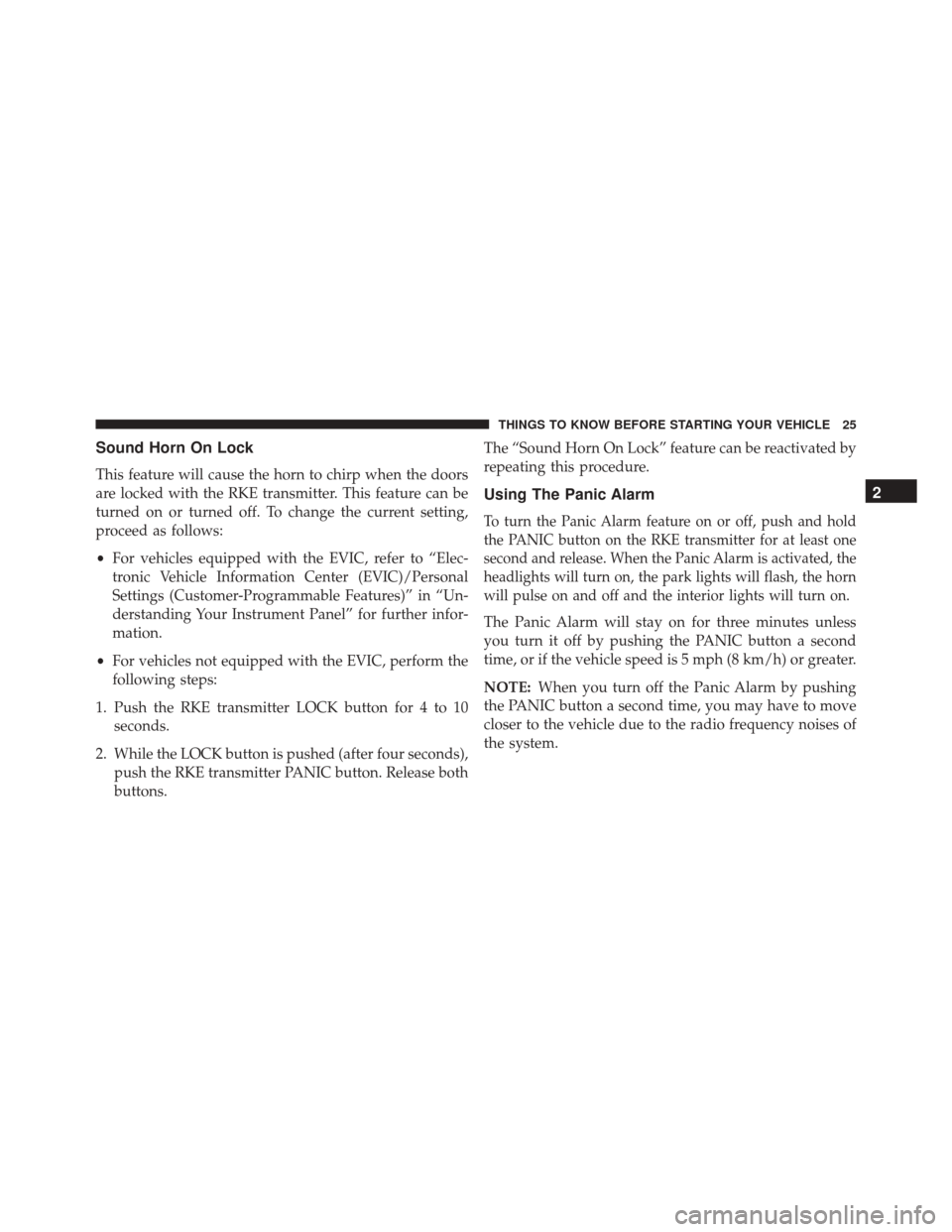
Sound Horn On Lock
This feature will cause the horn to chirp when the doors
are locked with the RKE transmitter. This feature can be
turned on or turned off. To change the current setting,
proceed as follows:
•For vehicles equipped with the EVIC, refer to “Elec-
tronic Vehicle Information Center (EVIC)/Personal
Settings (Customer-Programmable Features)” in “Un-
derstanding Your Instrument Panel” for further infor-
mation.
• For vehicles not equipped with the EVIC, perform the
following steps:
1. Push the RKE transmitter LOCK button for 4 to 10 seconds.
2. While the LOCK button is pushed (after four seconds), push the RKE transmitter PANIC button. Release both
buttons. The “Sound Horn On Lock” feature can be reactivated by
repeating this procedure.
Using The Panic Alarm
To turn the Panic Alarm feature on or off, push and hold
the PANIC button on the RKE transmitter for at least one
second and release. When the Panic Alarm is activated, the
headlights will turn on, the park lights will flash, the horn
will pulse on and off and the interior lights will turn on.
The Panic Alarm will stay on for three minutes unless
you turn it off by pushing the PANIC button a second
time, or if the vehicle speed is 5 mph (8 km/h) or greater.
NOTE:
When you turn off the Panic Alarm by pushing
the PANIC button a second time, you may have to move
closer to the vehicle due to the radio frequency noises of
the system.
2
THINGS TO KNOW BEFORE STARTING YOUR VEHICLE 25
Page 28 of 705
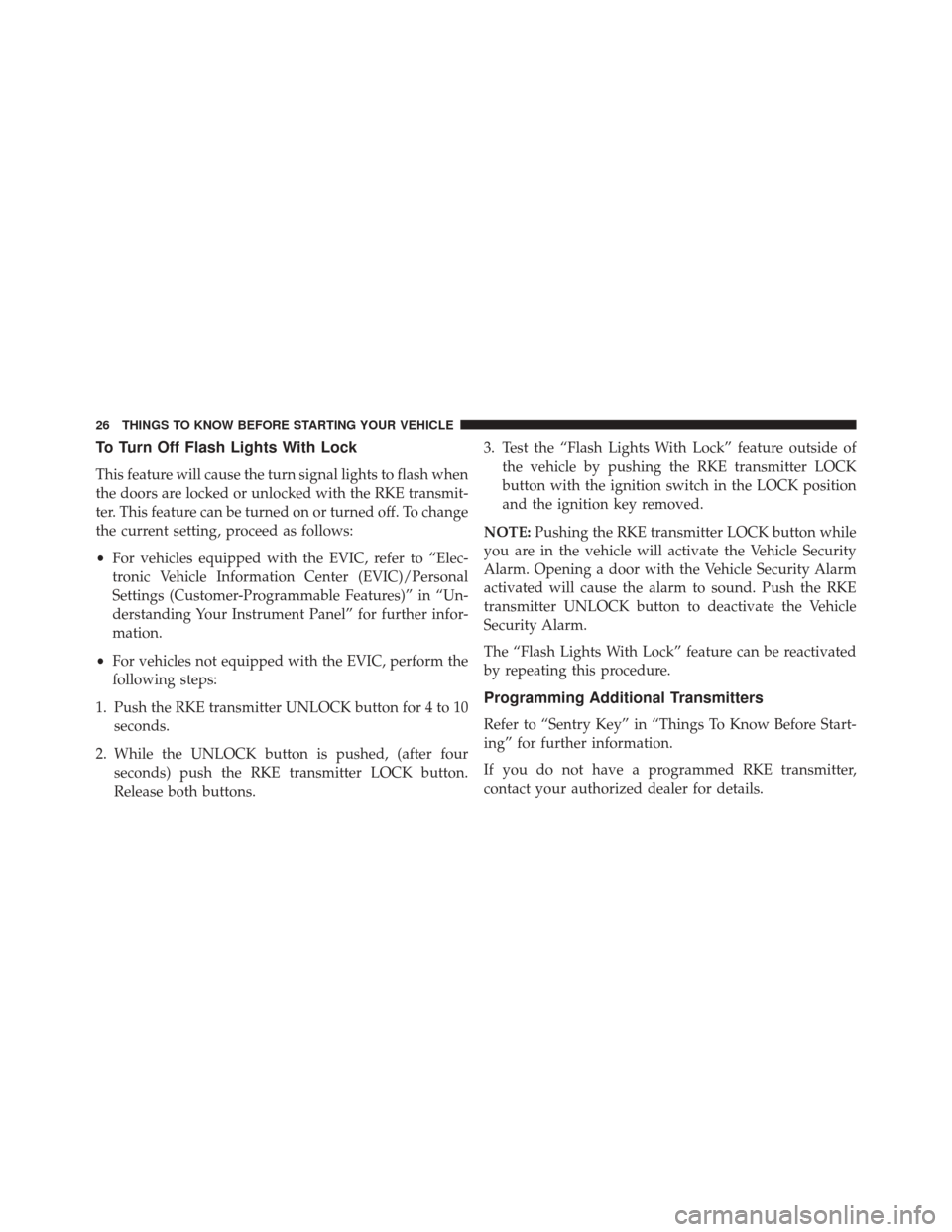
To Turn Off Flash Lights With Lock
This feature will cause the turn signal lights to flash when
the doors are locked or unlocked with the RKE transmit-
ter. This feature can be turned on or turned off. To change
the current setting, proceed as follows:
•For vehicles equipped with the EVIC, refer to “Elec-
tronic Vehicle Information Center (EVIC)/Personal
Settings (Customer-Programmable Features)” in “Un-
derstanding Your Instrument Panel” for further infor-
mation.
• For vehicles not equipped with the EVIC, perform the
following steps:
1. Push the RKE transmitter UNLOCK button for 4 to 10 seconds.
2. While the UNLOCK button is pushed, (after four seconds) push the RKE transmitter LOCK button.
Release both buttons. 3. Test the “Flash Lights With Lock” feature outside of
the vehicle by pushing the RKE transmitter LOCK
button with the ignition switch in the LOCK position
and the ignition key removed.
NOTE: Pushing the RKE transmitter LOCK button while
you are in the vehicle will activate the Vehicle Security
Alarm. Opening a door with the Vehicle Security Alarm
activated will cause the alarm to sound. Push the RKE
transmitter UNLOCK button to deactivate the Vehicle
Security Alarm.
The “Flash Lights With Lock” feature can be reactivated
by repeating this procedure.
Programming Additional Transmitters
Refer to “Sentry Key” in “Things To Know Before Start-
ing” for further information.
If you do not have a programmed RKE transmitter,
contact your authorized dealer for details.
26 THINGS TO KNOW BEFORE STARTING YOUR VEHICLE
Page 46 of 705
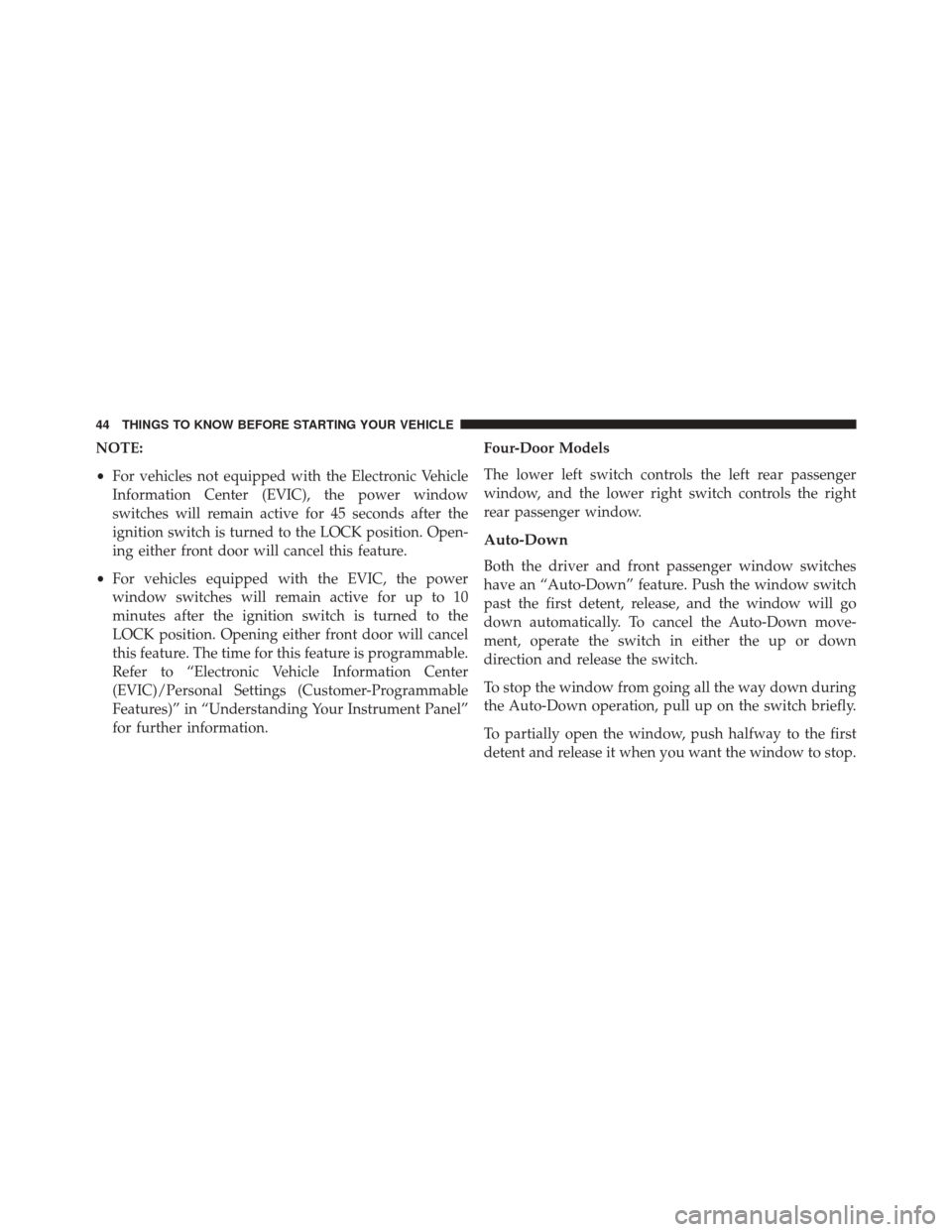
NOTE:
•For vehicles not equipped with the Electronic Vehicle
Information Center (EVIC), the power window
switches will remain active for 45 seconds after the
ignition switch is turned to the LOCK position. Open-
ing either front door will cancel this feature.
• For vehicles equipped with the EVIC, the power
window switches will remain active for up to 10
minutes after the ignition switch is turned to the
LOCK position. Opening either front door will cancel
this feature. The time for this feature is programmable.
Refer to “Electronic Vehicle Information Center
(EVIC)/Personal Settings (Customer-Programmable
Features)” in “Understanding Your Instrument Panel”
for further information. Four-Door Models
The lower left switch controls the left rear passenger
window, and the lower right switch controls the right
rear passenger window.
Auto-Down
Both the driver and front passenger window switches
have an “Auto-Down” feature. Push the window switch
past the first detent, release, and the window will go
down automatically. To cancel the Auto-Down move-
ment, operate the switch in either the up or down
direction and release the switch.
To stop the window from going all the way down during
the Auto-Down operation, pull up on the switch briefly.
To partially open the window, push halfway to the first
detent and release it when you want the window to stop.
44 THINGS TO KNOW BEFORE STARTING YOUR VEHICLE
Page 65 of 705
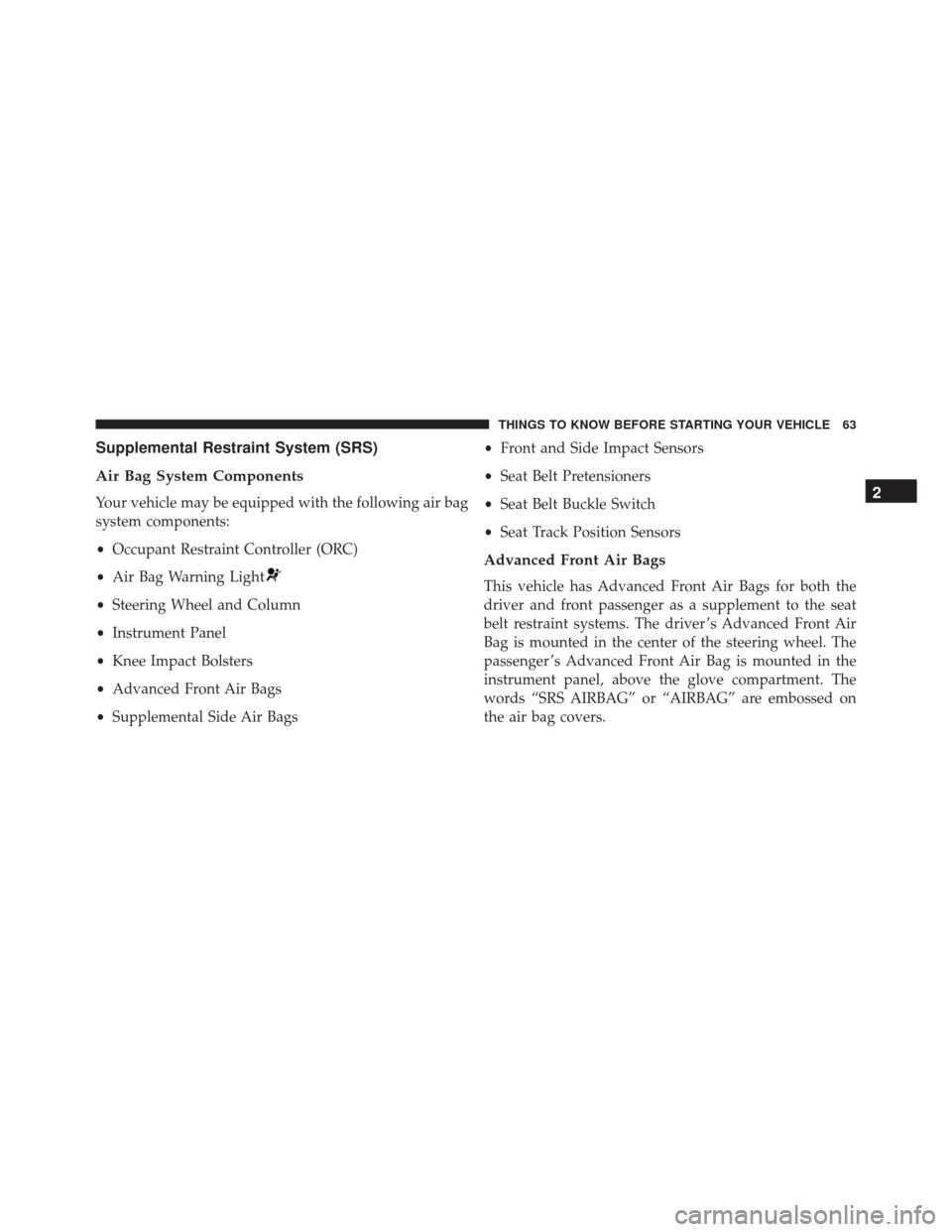
Supplemental Restraint System (SRS)
Air Bag System Components
Your vehicle may be equipped with the following air bag
system components:
•Occupant Restraint Controller (ORC)
• Air Bag Warning Light
•Steering Wheel and Column
• Instrument Panel
• Knee Impact Bolsters
• Advanced Front Air Bags
• Supplemental Side Air Bags •
Front and Side Impact Sensors
• Seat Belt Pretensioners
• Seat Belt Buckle Switch
• Seat Track Position Sensors
Advanced Front Air Bags
This vehicle has Advanced Front Air Bags for both the
driver and front passenger as a supplement to the seat
belt restraint systems. The driver ’s Advanced Front Air
Bag is mounted in the center of the steering wheel. The
passenger ’s Advanced Front Air Bag is mounted in the
instrument panel, above the glove compartment. The
words “SRS AIRBAG” or “AIRBAG” are embossed on
the air bag covers.
2
THINGS TO KNOW BEFORE STARTING YOUR VEHICLE 63
Page 66 of 705
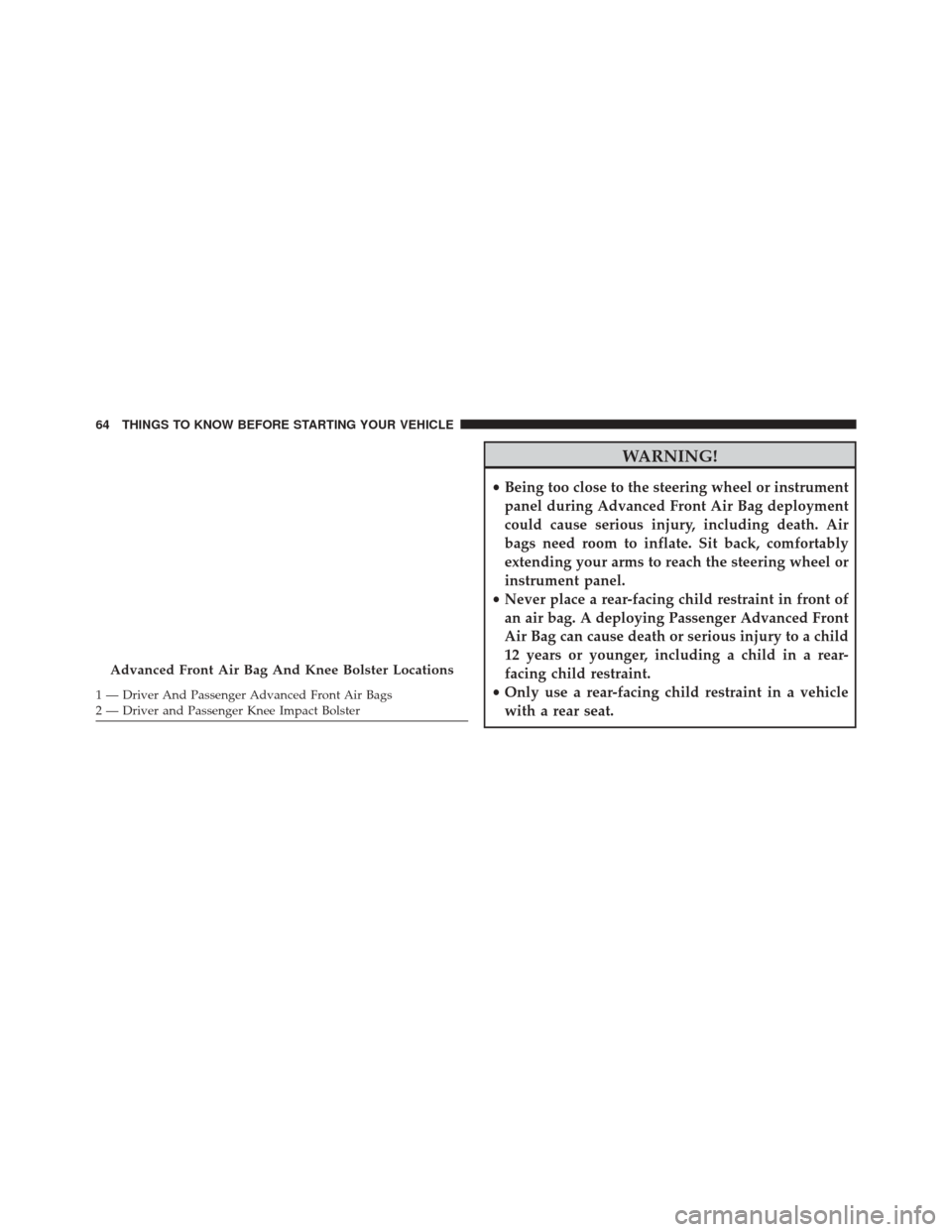
WARNING!
•Being too close to the steering wheel or instrument
panel during Advanced Front Air Bag deployment
could cause serious injury, including death. Air
bags need room to inflate. Sit back, comfortably
extending your arms to reach the steering wheel or
instrument panel.
• Never place a rear-facing child restraint in front of
an air bag. A deploying Passenger Advanced Front
Air Bag can cause death or serious injury to a child
12 years or younger, including a child in a rear-
facing child restraint.
• Only use a rear-facing child restraint in a vehicle
with a rear seat.
Advanced Front Air Bag And Knee Bolster Locations
1 — Driver And Passenger Advanced Front Air Bags
2 — Driver and Passenger Knee Impact Bolster 64 THINGS TO KNOW BEFORE STARTING YOUR VEHICLE
Page 67 of 705
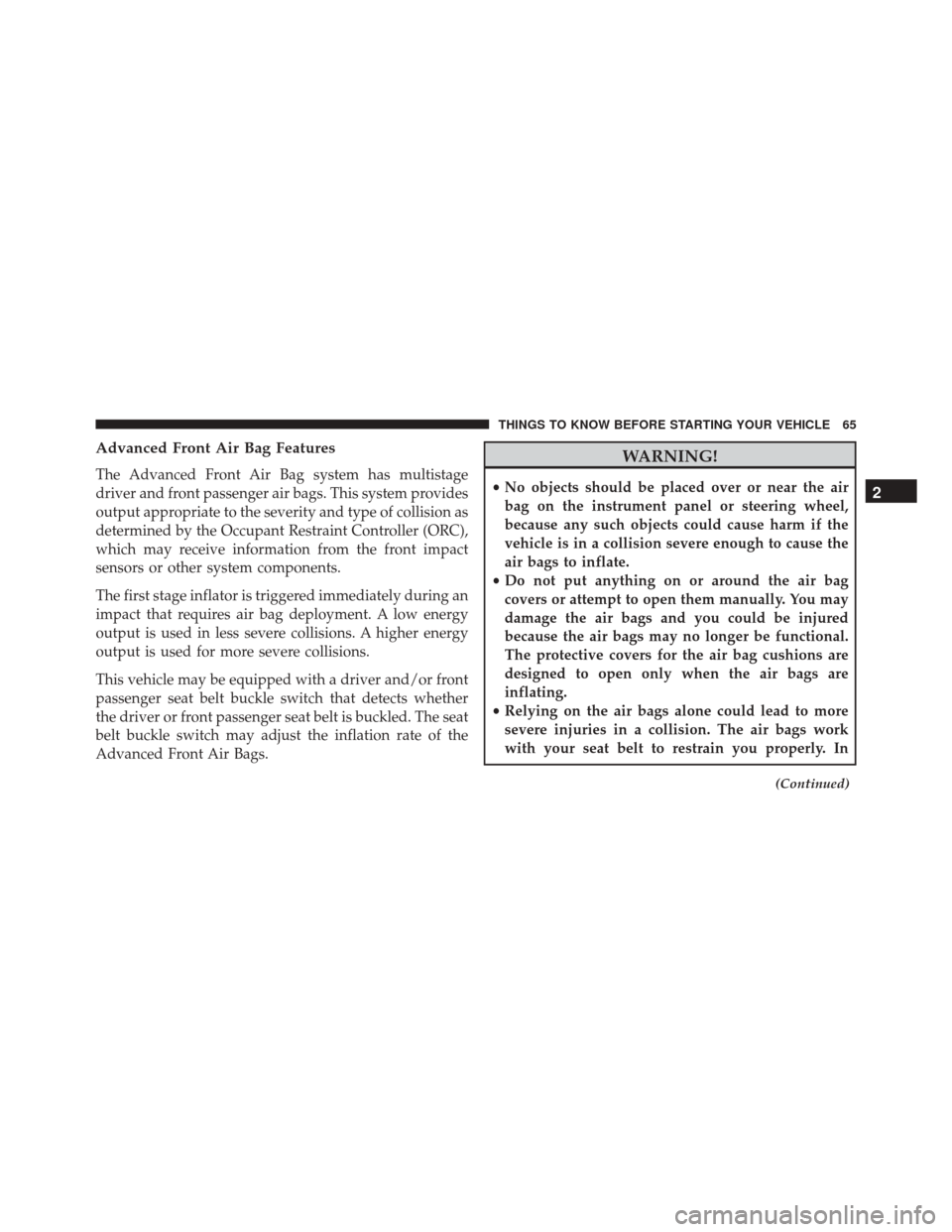
Advanced Front Air Bag Features
The Advanced Front Air Bag system has multistage
driver and front passenger air bags. This system provides
output appropriate to the severity and type of collision as
determined by the Occupant Restraint Controller (ORC),
which may receive information from the front impact
sensors or other system components.
The first stage inflator is triggered immediately during an
impact that requires air bag deployment. A low energy
output is used in less severe collisions. A higher energy
output is used for more severe collisions.
This vehicle may be equipped with a driver and/or front
passenger seat belt buckle switch that detects whether
the driver or front passenger seat belt is buckled. The seat
belt buckle switch may adjust the inflation rate of the
Advanced Front Air Bags.
WARNING!
•No objects should be placed over or near the air
bag on the instrument panel or steering wheel,
because any such objects could cause harm if the
vehicle is in a collision severe enough to cause the
air bags to inflate.
• Do not put anything on or around the air bag
covers or attempt to open them manually. You may
damage the air bags and you could be injured
because the air bags may no longer be functional.
The protective covers for the air bag cushions are
designed to open only when the air bags are
inflating.
• Relying on the air bags alone could lead to more
severe injuries in a collision. The air bags work
with your seat belt to restrain you properly. In
(Continued)
2
THINGS TO KNOW BEFORE STARTING YOUR VEHICLE 65
Page 68 of 705
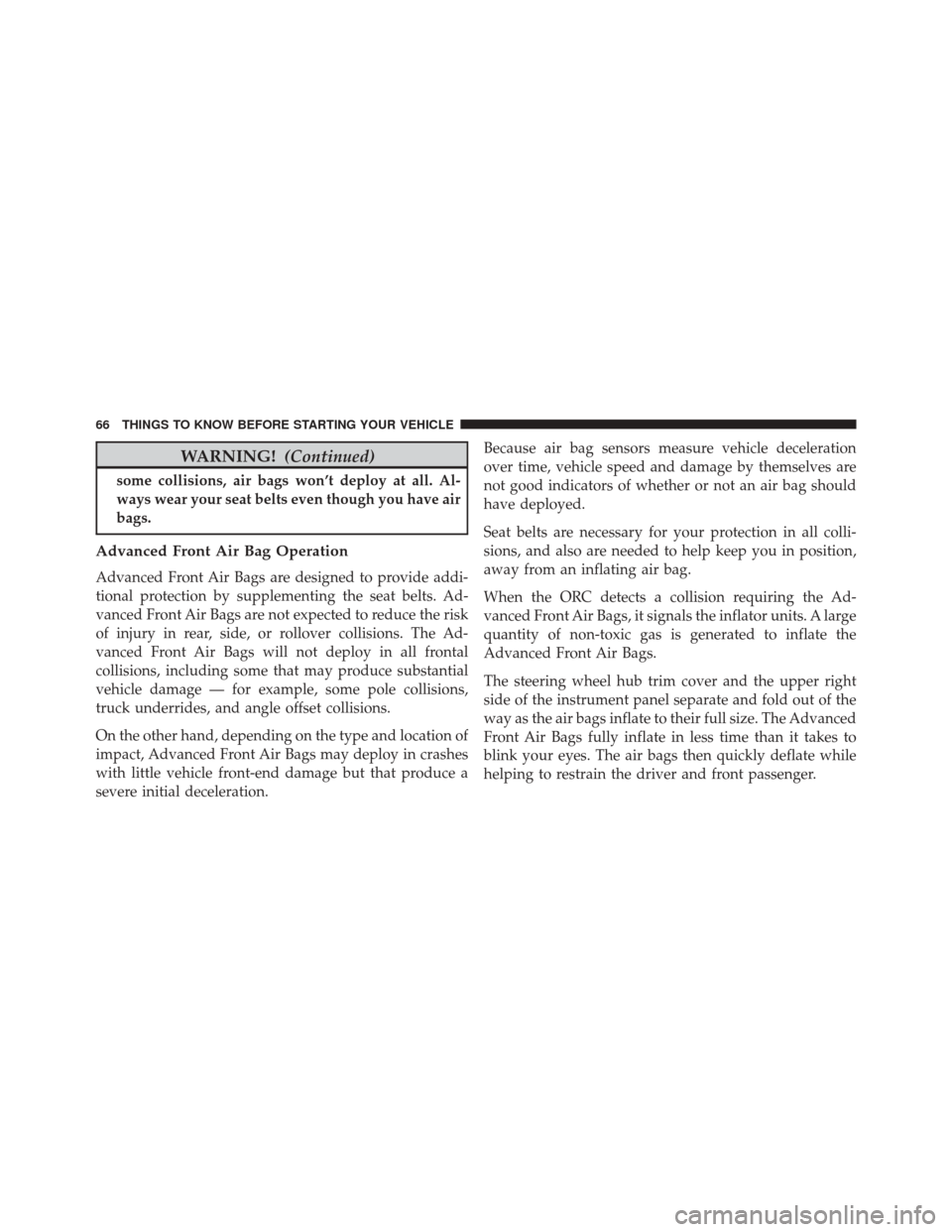
WARNING!(Continued)
some collisions, air bags won’t deploy at all. Al-
ways wear your seat belts even though you have air
bags.
Advanced Front Air Bag Operation
Advanced Front Air Bags are designed to provide addi-
tional protection by supplementing the seat belts. Ad-
vanced Front Air Bags are not expected to reduce the risk
of injury in rear, side, or rollover collisions. The Ad-
vanced Front Air Bags will not deploy in all frontal
collisions, including some that may produce substantial
vehicle damage — for example, some pole collisions,
truck underrides, and angle offset collisions.
On the other hand, depending on the type and location of
impact, Advanced Front Air Bags may deploy in crashes
with little vehicle front-end damage but that produce a
severe initial deceleration. Because air bag sensors measure vehicle deceleration
over time, vehicle speed and damage by themselves are
not good indicators of whether or not an air bag should
have deployed.
Seat belts are necessary for your protection in all colli-
sions, and also are needed to help keep you in position,
away from an inflating air bag.
When the ORC detects a collision requiring the Ad-
vanced Front Air Bags, it signals the inflator units. A large
quantity of non-toxic gas is generated to inflate the
Advanced Front Air Bags.
The steering wheel hub trim cover and the upper right
side of the instrument panel separate and fold out of the
way as the air bags inflate to their full size. The Advanced
Front Air Bags fully inflate in less time than it takes to
blink your eyes. The air bags then quickly deflate while
helping to restrain the driver and front passenger.
66 THINGS TO KNOW BEFORE STARTING YOUR VEHICLE